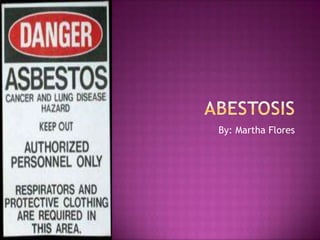
Asbestosis
- 1. Abestosis By: Martha Flores
- 2. what is asbestosis? It is known as “diffused pulmonary fibrosis” which is caused by inhalation of asbestos fibers. Is most often seen with those who work with asbestos or asbestos containing products.
- 3. How Asbestosis develops? It isn't easy for foreign matter to enter the lungs. As a matter of fact, the nose and the bronchi act as filters and are able to stop most particles before they even gets close to one's lungs. But because asbestos fibers are thin, needle-like, and microscopic, they are able to penetrate the filters and make their way into the lungs, where they usually lodge in the lining of the lung, known as the pleura. The presence of asbestos in the lungs eventually causes scarring or "fibrosis," which may later result in the formation of tumors and the development of cancer.
- 5. Symptoms of Asbestosis The symptoms of asbestosis do not appear quickly. It can take as long as 10 to 40 years to begin to recognize symptoms that indicate a problem with the lungs. The most common symptoms of this occupational disease are:
- 6. Shortness of breath (dyspnea) - This is often the first symptom to appear and, as mentioned before, it may be ten or more years before shortness of breath is evident. In the early stages of the disease, the shortness of breath will occur only after extreme exertion, but as the asbestosis progresses, the dyspnea will occur on a more regular basis.
- 7. Persistent, dry cough - This troublesome cough, which often makes it difficult to sleep and eat, may be accompanied by chest pain. The victim may also find blood in the sputum.
- 8. Chest tightness - Many victims of asbestosis believe they have heart disease or are having a heart attack because the pain can be similar. The pain or tightness is caused by scar tissue that does not expand properly or with ease during the breathing process.
- 9. Loss of appetite - This is often a result of the combination of the other annoying symptoms of the disease. Some victims also report difficulty swallowing, which makes eating uncomfortable.
- 10. Clubbing of fingers (advanced stages) - This increased curvature of the nails and thickening of the digits is often indicative of a serious pulmonary disorder such as asbestosis.
- 12. How does it look in X-rays? Chest X-ray- irregular opacities in the lower lobes, heart border becomes shaggy. In the late stages of disease, there is a honey-comb likeness and volume loss.
- 14. Treatment Of Asbestosis There is no cure for asbestosis. A patient needs to have regular check-ups with their doctor to follow the disease process and treat accordingly. Presently steroids can be attempted to treat the inflammation. In the very most severe cases of asbestosis there are lung and heart and lung transplants. Asbestosis increases the risk of the development of lung cancer 5 fold, however, if a smoker has asbestosis, the risk is increased 92 fold !!
- 15. OVerview Today asbestos is no longer being used in industry or construction. Always see your doctor for signs and symptoms (coughing, shortness of breath) or if you have had exposure to asbestos and are not yet experiencing any of the symptoms. With a complete history, physical and diagnostic exam you can detect asbestosis and rule out any other lung diseases and treat accordingly.
